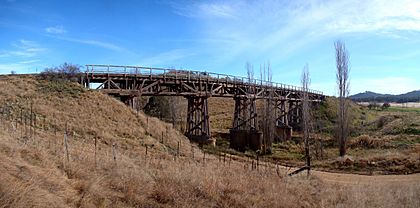Ingalara Creek railway bridge, Colinton facts for kids
Quick facts for kids Ingalara Creek railway bridge |
|
|---|---|
 |
|
| Coordinates | 35°49′07″S 149°10′36″E / 35.8186°S 149.1768°E |
| Carries | Bombala railway line |
| Crosses | Ingalara Creek |
| Locale | Michelago, Monaro region, New South Wales, Australia |
| Owner | RailCorp |
| Characteristics | |
| Design | Queen post truss viaduct |
| Material | Timber |
| Longest span | 12.8 metres (42 ft) |
| Number of spans | 5 by 42ft, 2 by 20ft |
| Piers in water | 0 |
| History | |
| Designer | John Whitton |
| Constructed by | NSW Government Railways |
| Construction end | 1889 |
| Official name | Michelago rail bridge over Ingalara Creek; Ingalara Creek Railway Viaduct |
| Designated | 2 April 1999 |
| Reference no. | 1048 |
The Ingalara Creek railway bridge is a special historical bridge in New South Wales, Australia. It used to carry the Bombala railway line over Ingalara Creek near Michelago. This bridge was designed by John Whitton, who was the main engineer for railways at the time. It was built in 1889.
The bridge is also known as the Michelago Rail Bridge over Ingalara Creek or the Ingalara Creek Railway Viaduct. It is owned by RailCorp, a government group in New South Wales. Because it's so important to history, it was added to the New South Wales State Heritage Register on April 2, 1999. This means it's protected and recognized as a significant part of the state's past.
Contents
Building the Railway
The railway line was extended from Queanbeyan to Cooma between 1887 and 1889. At this time, the government wanted to save money on building railways. So, John Whitton, the chief railway engineer, often chose to build bridges out of timber (wood). Most of these were simple timber beam bridges.
However, for two big waterways, Ingalara Creek and the Bredbo River (where the Bredbo Rail Bridge is), Whitton decided to use a different, stronger design. He chose "Queen post deck trusses." A "truss" is a strong framework, usually made of triangles, that helps a bridge hold a lot of weight. A "viaduct" is a long bridge made of many arches or spans.
Whitton had already used this special timber truss design on the Main North line further north. He also built other similar bridges, like the ones over Beardy Waters and Severn River, which are also protected historical sites today.
What the Bridge Looks Like
The Michelago Rail Bridge over Ingalara Creek is a seven-span timber viaduct. This means it has seven main sections, or "spans," that cross the creek. Each of these main sections is about 42 feet (12.8 meters) long.
The strong framework, or "trusses," used in the bridge are called "Queen post" trusses. John Whitton copied this design from an old timber bridge in England. That bridge, called St Germans viaduct, was built about 30 years earlier by a famous engineer named Isambard Kingdom Brunel.
Even though trains don't use the bridge anymore and it hasn't been maintained much lately, it was reported to be in fair condition in 2006. All the main parts of these old timber viaducts still have their original materials.
Why This Bridge Is Special
The Ingalara Creek railway bridge is considered very important for several reasons:
A Smart Way to Build
This timber Queen post truss viaduct was a clever and affordable way to build the railway line from Queanbeyan to Cooma. It was built when money for railway construction was becoming harder to find. This bridge shows how engineers found smart solutions during that time.
An Impressive Sight
The bridge is easy to see from the Monaro Highway, and it's quite an impressive structure made of timber. Its design shows a high level of skill and creativity from the engineers who built it.
Helping the Region Grow
The Cooma Railway, which this bridge was a part of, greatly helped the Monaro Region grow and develop after it was built between 1887 and 1889. All the timber viaducts, including this one, were very important parts of the railway system that connected the region.
Strong and Lasting Design
The timber Queen post deck viaduct was a significant type of structure. It was used instead of the more expensive iron bridges that John Whitton often preferred. The Ingalara viaduct was built from very strong "ironbark" hardwood, which made it technically sound and durable, meaning it lasted a long time.
A Unique Type of Bridge
There are only a few of these specific "Queen post deck truss" timber viaducts left. These two on the Cooma Line, along with four others on the Main North Line, are a unique and rare type of railway bridge. This makes the Ingalara Creek bridge a special part of New South Wales's cultural history.
The Michelago rail bridge over Ingalara Creek was officially listed on the New South Wales State Heritage Register on April 2, 1999, because it met these important historical and design standards.

